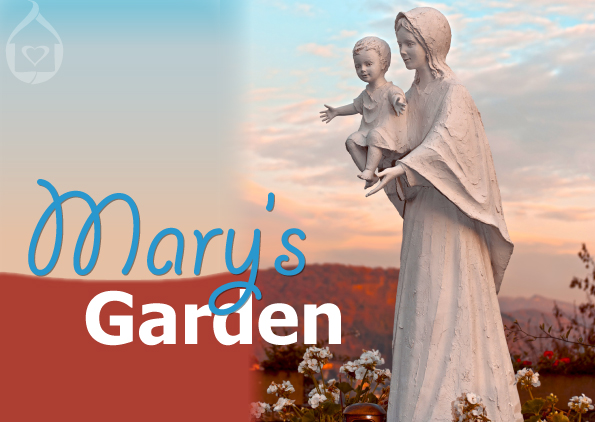Mary’s Garden

In this month of May, dedicated to our Mother Mary, consider planting a garden in her honour. Before Christianity, many flowers and plants were associated with pagan gods such as Diana, Venus and Juno. As Christianity spread, in recognition of God’s presence in and through the glory of nature, missionaries ‘christened’ many flowers with themes that related to Mary, Jesus and holy places. For example, the medieval names for ‘Baby’s Breath’ was ‘Lady’s Veil’, ‘Impatients’ was ‘Mother Love’ and ‘Jonquil’ was ‘St Joseph’s Staff’. Sadly, during the Protestant revolution, many of these flowers were renamed with more secular names. Yet still, the symbolism and Christian associations of these flowers are powerful reminders of the profound truths of our faith as well as being a delightful and joyous expression of devotion.
Here’s a few ideas to get your Mary’s Garden blooming.
Location: Renovate a secluded corner of your garden, build an enclosed space in generous yard, create a feature in a busy location, or dedicate a generous patio pot to the project. Even an indoor floral arrangement made from fresh, dried or satin flowers can be a Mary’s Garden. Alternatively, create a roadside shrine or lay claim to a derelict flower bed in a public park or the school grounds.
Feature artwork: Position a statue of our Lady as a focal point, or create something yourself using symbols of Mary’s titles such as hearts (Immaculate Heart), roses (Mystical Rose), or stars (Star of the Sea). Garden art can be created with clay or painted onto smooth stones or tiles which can then be glued to a wall or a stone paver. For pots and indoor arrangements, framed holy pictures, plastic figurines or other craft objects can be used.
Plants and Flowers: Plant flowers whose names reflect various devotions to our Lady such as Marigold (Mary’s gold), Morning Glory (Our Lady’s Mantle), Petunia (Lady’s Praise), Snapdragon (Child Jesus’ shoes), Tulip (Marys’ Prayer), Zinnia (the Virgin), Begonia (Heart of Mary), Calla Lily (St Joseph’s Staff), Daffodil (Mary’s Star), English Daisy (Mary Love), Maiden Hair (Our Lady’s Hair), Forget-me-nots (Eyes of Mary), Gladiolus (Twelve Apostles). For a more extensive list, including the Marian names of herbs, do an internet search or visit www.fisheaters.com/marygardens.html or www.mgardens.org
Meditation opportunities: Think about how you might use your garden. Will it simply be something that you and others admire from the side, or will it be a space that you can use for prayer? Think about placing a garden seat for easy contemplation and prayer, stepping stones or a spiral pathway upon which one can make a mini-pilgrimage.
The Rosary means ‘crown of roses’ and it is said that each time we pray a decade of the Rosary, we add a rose to Mary’s crown. Different colour roses are associated with different qualities of Mary – White is for her Purity, Red for her Sorrow, Gold for her Glory. |
Author: Francine Pirola
 Over to you! Did you have a little corner of your garden for Mary? Have you never done anything like this before? What are your favourite flowers and do they have a religious name? How did you go with making your Mary garden? Tell us in the comments below!
Over to you! Did you have a little corner of your garden for Mary? Have you never done anything like this before? What are your favourite flowers and do they have a religious name? How did you go with making your Mary garden? Tell us in the comments below!
More on Mary from CathFamily:

